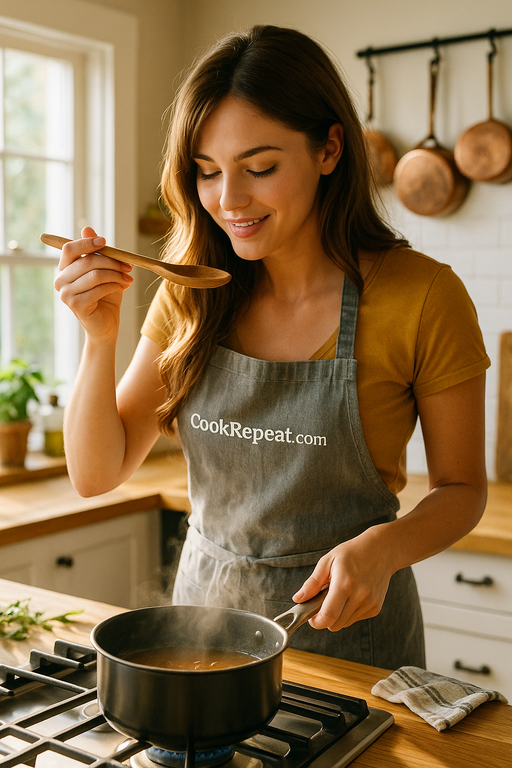
You follow the recipe.
And still, the food tastes... fine.
Not bad. Just flat.
It’s missing that deep, rich flavor you get at your favorite restaurant, the kind that makes you stop talking after the first bite.
It’s missing that deep, rich flavor you get at your favorite restaurant, the kind that makes you stop talking after the first bite.
Here’s the truth, chefs aren’t keeping secrets from you.
They’re just doing a few small things right, every single time.
They’re just doing a few small things right, every single time.
The Real Problem
Restaurant food tastes better because flavor is built, not added.
Chefs work in layers of heat, seasoning, and time.
Chefs work in layers of heat, seasoning, and time.
At home, we often skip one of those steps.
We salt only at the end.
We stir too much and never let anything brown.
We rush the meal before the flavors have time to blend.
We salt only at the end.
We stir too much and never let anything brown.
We rush the meal before the flavors have time to blend.
Each shortcut costs you flavor.
The difference between “fine” and “fantastic” isn’t your ingredients.
It’s attention.
The difference between “fine” and “fantastic” isn’t your ingredients.
It’s attention.
Why Most Fixes Don’t Work
When food tastes flat, most people try to fix it by adding more.
More salt.
More sauce.
More butter.
More salt.
More sauce.
More butter.
But you can’t rescue flavor that never had a chance to form.
If you don’t build it early, you’ll always be chasing it later.
If you don’t build it early, you’ll always be chasing it later.
Real flavor comes from chemistry, not garnish.
The brown bits on the bottom of the pan.
The acid that cuts through fat.
The seasoning that happens before you even start cooking.
The brown bits on the bottom of the pan.
The acid that cuts through fat.
The seasoning that happens before you even start cooking.
You can’t fake that with a handful of herbs at the end.
The Skill: Taste in Layers
Chefs don’t just follow recipes. They listen to their food.
They salt the chicken before it hits the pan.
They taste halfway through to see what’s missing.
They finish with something bright to bring everything into balance.
They taste halfway through to see what’s missing.
They finish with something bright to bring everything into balance.
That’s how flavor is built, not in one move, but in a series of small, intentional choices.
Cooking gets easier when you stop treating recipes like laws and start treating them like maps.
Make this your habit:
Boil. Taste. Adjust. Repeat.
Make this your habit:
Boil. Taste. Adjust. Repeat.
Practical Fixes You Can Try Tonight
Control your heat.
High heat builds flavor through browning. That’s the sizzle that gives steak its crust and vegetables their edge.
Low heat deepens flavor with slow simmering and reduction.
Most home cooks live somewhere in between, where nothing really happens.
High heat builds flavor through browning. That’s the sizzle that gives steak its crust and vegetables their edge.
Low heat deepens flavor with slow simmering and reduction.
Most home cooks live somewhere in between, where nothing really happens.
Season in stages.
Salt early so it can draw moisture and start the work before the pan gets hot.
Taste midway and adjust.
Finish with acid or something fresh. A squeeze of lemon, a splash of vinegar, or a drizzle of oil can transform the whole dish.
Salt early so it can draw moisture and start the work before the pan gets hot.
Taste midway and adjust.
Finish with acid or something fresh. A squeeze of lemon, a splash of vinegar, or a drizzle of oil can transform the whole dish.
Deglaze the pan.
Those brown bits aren’t burnt. They’re flavor.
Add a splash of wine, stock, or even water, and scrape gently.
You’ve just made an instant sauce.
Those brown bits aren’t burnt. They’re flavor.
Add a splash of wine, stock, or even water, and scrape gently.
You’ve just made an instant sauce.
Taste before you serve.
Always.
That last spoonful tells you what’s missing.
Salt for strength.
Acid for balance.
Or nothing at all, which is its own reward.
Always.
That last spoonful tells you what’s missing.
Salt for strength.
Acid for balance.
Or nothing at all, which is its own reward.
The Takeaway
You don’t need a restaurant kitchen.
You need awareness.
You need awareness.
Taste early. Taste often.
Let things brown.
Give them time.
Let things brown.
Give them time.
When you cook with that kind of attention, your food won’t just taste better.
It will taste alive.
It will taste alive.